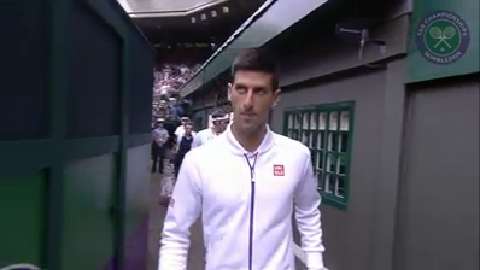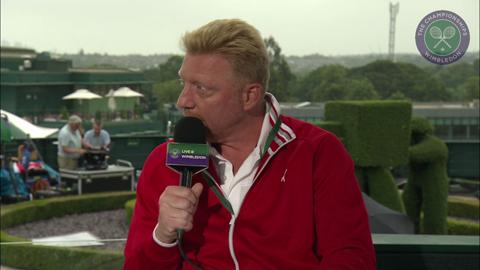When the predictions and previews emerge ahead of a Novak Djokovic and Roger Federer Grand Slam final – and there have been a few – the focus is often on how Federer’s venerable serve will match up against Djokovic’s stellar return.
What few saw coming this time is how dominant the Serb would be with his own delivery. In fact, throughout his 7-6(1), 6-7(10), 6-4, 6-3 victory over Federer in Sunday’s Wimbledon final – a battle between the world’s two top-ranked players and a rematch of the 2014 finale – Djokovic dominated everywhere. On serve. With his return. In most rallies. He was quicker. He was sharper. He was steadier. And he was mentally stronger. All of these factors combined to produce a performance from the No.1 seed that improved as the match wore on. It delivered him his third Wimbledon title.
This is where the two-hour, 56-minute final was won and lost.
Serve and Return
Federer put on a serving clinic in his semi-final victory over Andy Murray, landing more than three-quarters of his first serves and winning more than 80 per cent of those points.
Yet against Djokovic, those figures were down. It was a combination of two factors: Federer had a slight dip in his serving level while Djokovic’s return was lethal.
According to Todd Woodbridge, the nine-time Wimbledon doubles champion: “Federer's percentage wasn’t as high as it was in the semi – that was extraordinary. But it was still in the high 60s. You say to anybody, you serve in the high 60s and you’re going to do well in any match.

“The key, though, on Federer’s serve was that, from midway through the second set, Djokovic’s returning was amazing, and particularly in the third and fourth. He got them hard, he got them deep into court and they were off solid serves. He was reading Federer’s serve better than anybody and getting them back into positions where Federer couldn’t be offensive.”
Yet Djokovic was also extremely impressive on his own serve. The Serb, surprisingly, led the ace tally for the first two sets, and matched Federer in first serve percentage and first serve points won.
When receiving in the fourth set, Federer managed to win just six points. And Djokovic’s serve held up under pressure – he staved off set points with powerful first serves in the 12th game of the first set and was broken just once, despite Federer gaining seven break points. “Djokovic’s serve was better than Federer’s on big points,” Woodbridge said.
There is a saying in tennis that you are only as good as your second serve and by that measure alone, Djokovic was superior – he finished the match winning 60 per cent of his second-serve points, while Federer managed just 49 per cent.
Off the Ground
The differences in the two players’ approach to the baseline battle was obvious. Federer was all about aggressive, first-strike tennis, while Djokovic was more content to rally and construct the point, relying on his court coverage and defence to keep him alive before picking the perfect moment to attack. The longer the rallies went on, the stronger Djokovic became. He won nearly twice the number of points that extended to nine shots or more.
Federer’s go-for-broke style was rewarded with plenty of winners, but also far more unforced errors than the No.1 seed. Credit must go to him for trying to seize the initiative, but too often he sprayed a wild error just when he needed to be consistent.
“Djokovic is so strong off the ground in defence; he’s an impenetrable wall who gets so many extra balls back, but not just back – he gets them back into positions where he has neutralised the point,” Woodbridge observed. “Any time that Federer got into a play where Djokovic could go hard cross-court, that was the one where Federer had to run onto the forehand, and that’s a weak shot from him. That’s the shot where [opponents] break him down. And that’s the shot where you see him shank and slightly miss.

“Probably midway through the third, it was noticeable that he started to take really big, long strides to run to the forehand, and he wasn’t getting to the ball. And that’s physical as well.”
Djokovic was the fresher and the faster as the match wore on, and also had the sense to adjust his court positioning to alter the complexion of the match. Blowing seven set points in the second set after rallying passively and letting Federer dictate, he moved further up the court. He played almost half of his shots inside the baseline in the third set, compared with just 30 per cent during the first two sets. The turnaround was significant; Djokovic steamrollered through the last two sets in just over one hour.
In the Mind
Djokovic's collapse in the second set from also exemplified his ability to overcome adversity. The Serb is an expressive, emotional player but did a sterling job to remain calm and steady for the vast majority of the match. His zen-like state only truly cracked once, after dropping the second set in an epic tie-break. As the crowd celebrated wildly and Federer pumped his fist, Djokovic angrily banged his racket against his shoes and was livid at the change of ends.
Just a few games later, he was a picture of focus once more, and promptly broke serve to move ahead 3-1. It was the only break of the third, yet a decisive one as he rode that advantage for the rest of the set to take a two-sets-to-one lead.
“One of his great qualities is that he let his emotion go, he got it out, and then he re-set," Woodbridge said. "And he re-set immediately to bounce back. That’s what great players have that ability to do. To turn that around so quickly, that was a quality that stood out in the match. Because without that, Federer could have gotten on top quickly.
"I think, in the end, Roger didn’t hang his head, so to speak, but his eye focused down midway through the third set. And he really internalised a little bit; you could sense that he felt that ‘I don’t know if I can find anything more to penetrate this guy and how I’m going to beat him’.”



